A Gadolinium(III) Complex Based on Pyridoxine Molecule with Single-Ion Magnet and Magnetic Resonance Imaging Properties
Abstract
1. Introduction
2. Results and Discussion
2.1. Description of the Crystal Structure
2.2. Analysis of the Hirshfeld Surfaces
2.3. Magnetic Properties Study
2.4. MR Imaging Phantom Studies
3. Materials and Methods
3.1. Preparation of the Complex
Synthesis of 1
3.2. X-ray Data Collection
3.3. Technical Equipment, Devices and Physical Measurements
4. Conclusions
Supplementary Materials
Author Contributions
Funding
Data Availability Statement
Acknowledgments
Conflicts of Interest
References
- Hellmann, H.; Mooney, S. Vitamin B6: A molecule for human health? Molecules 2010, 15, 442–459. [Google Scholar] [CrossRef] [PubMed]
- Geng, M.Y.; Saito, H.; Katsuki, H. Effects of vitamin B6 and its related compounds on survival of cultured brain neurons. Neurosci. Res. 1995, 24, 61–65. [Google Scholar] [CrossRef] [PubMed]
- Riordan, H.D.; Mikirova, N.; Taylor, P.R.; Feldkamp, C.A.; Casciari, J.J. The Effects of a Primary Nutritional Deficiency (Vitamin B Study). Food Sci. Nutr. 2012, 3, 1238–1244. [Google Scholar] [CrossRef]
- Da Silva, V.R.; Russell, K.S.; Gregory, J.F., III. Vitamin B6. Present Knowledge in Nutrition, 10th ed.; Erdman, Jr., Macdonald, I.A., Zeisel, S.H., Eds.; Wiley: Hoboken, NJ, USA, 2012. [Google Scholar]
- Parra, M.; Stahl, S.; Hellmann, H. Vitamin B6 and Its Role in Cell Metabolism and Physiology. Cells 2018, 7, 84. [Google Scholar] [CrossRef] [PubMed]
- Percudani, R.; Peracchi, A. The B6 database: A tool for the description and classification of vitamin B6-dependent enzymatic activities and of the corresponding protein families. BMC Bioinform. 2009, 10, 273. [Google Scholar] [CrossRef] [PubMed]
- Mosset, A.; Nepveu-Juras, F.; Harpin, R.; Bonnet, J.-J. Complexation of the vitamin B6 with the Cd2+ cation: NMR and X-ray structural study. J. Inorg. Nucl. Chem. 1978, 40, 1259–1263. [Google Scholar] [CrossRef]
- Sabirov, V.K.; Porai-Koshitz, M.A.; Struchkov, Y.T. Structure of the dimeric complex of iron(III) chloride with pyridoxine. Acta Cryst. 1993, C49, 1611–1614. [Google Scholar] [CrossRef]
- Sudhakara Rao, S.P.; Varughese, K.I.; Manohar, H. Ternary metal complexes of anionic and neutral pyridoxine (vitamin B6) with 2,2′-bipyridine. Syntheses and X-ray structures of (pyridoxinato)bis(2,2′-bipyridyl)cobalt(III) perchlorate and chloro(2,2′-bipyridyl)(pyridoxine)copper(II) perchlorate hydrate. Inorg. Chem. 1986, 25, 734–740. [Google Scholar] [CrossRef]
- Mathews, I.I.; Manohar, H. Crystallographic identification of a ‘stepped-cubane’ structure for the Cu4O4 core in [Cu4L2(bipy)4(µ3-OH)2][ClO4]4(HL = 5-hydroxy-6-methylpyridine-3,4-dimethanol, bipy = 2,2′-bipyridine). J. Chem. Soc. Dalton Trans. 1991, 2139–2143. [Google Scholar] [CrossRef]
- Mathews, I.I.; Sudhakara Rao, S.P.; Nethaji, N. X-ray crystal structure of a ternary copper(II) vitamin B6 complex, hydroxo(2,2′-bipyridyl)(pyridoxinato) copper(II) monohydrate. A rare example of monodentate coordination of copper(II) by the hydroxyl ion. Polyhedron 1992, 11, 1397–1401. [Google Scholar] [CrossRef]
- Casas, J.S.; Castellano, E.E.; Condori, F.; Couce, M.D.; Sanchez, A.; Sordo, J.; Varela, J.M.; Zuckerman-Schpector, J. Synthesis of complexes of dimethyltin(IV) with mono- and di-deprotonated pyridoxine (PN) in media with various anions. Crystal structures of [SnMe2(PN–H)]NO3·2H2O, [SnMe2(H2O)(PN–H)]Cl·H2O and [SnMe2(H2O)(PN–2H)]·0.5H2O. J. Chem. Soc. Dalton Trans. 1997, 4421–4430. [Google Scholar] [CrossRef]
- Casas, J.S.; Castiñeiras, A.; Condori, F.; Couce, M.D.; Russo, U.; Sanchez, A.; Sordo, J.; Varela, J.M. Reaction of the diethyltin(IV) cation with pyridoxine (PN, vitamin B6) in the presence of various anionic species: The crystal structure of [SnEt2(PN–H)]Cl. Polyhedron 2000, 19, 813–819. [Google Scholar] [CrossRef]
- Casas, J.S.; Castiñeiras, A.; Condori, F.; Couce, M.D.; Russo, U.; Sánchez, A.; Sordo, J.; Varela, J.M.; Vázquez-López, E.M. Diorganotin(IV) complexes of dideprotonated pyridoxine (PN, vitamin B6). The crystal structures of [SnEt2(PN-2H)]·CH3OH, [SnEt2(PN-2H)(DMSO)] and [SnBu2(PN-2H)]. J. Organomet. Chem. 2004, 689, 620–626. [Google Scholar] [CrossRef]
- Bonfada, E.; de Oliveira, G.M.; Back, D.F.; Lang, E.S. Metallation of Ligands with Biological Activity: Synthesis and X-Ray Characterization of [UO2(PN)2(H2O)]Cl2 {PN = vitamin B6 pyridoxine[2-methyl-3-hydroxy-4, 5-bis(hydroxymethyl) pyridine]}. Z. Anorg. Allg. Chem. 2005, 631, 878–881. [Google Scholar] [CrossRef]
- Casas, J.S.; Couce, M.D.; Sánchez, A.; Sordo, J.; Vázquez-López, E.M. Synthesis, structure and cytotoxicity studies on diorganotin (R = Me, Et) complexes of N-methylpyridoxine (MePN, PN = Vitamin B6) containing different anions. J. Organomet. Chem. 2012, 696, 4236–4247. [Google Scholar] [CrossRef]
- Casas, J.S.; Couce, M.D.; Sánchez, A.; Sordo, J.; Vázquez-López, E.M. Hydrogen bonded water–halide {[(H2O)4X2]2−}n (X = Cl, Br) tapes as organizing units in crystals containing [SnMe2(MePN–H)]22+ cations (MePN = N-methylpyridoxine). Inorg. Chem. Commun. 2013, 30, 156–158. [Google Scholar] [CrossRef]
- Marino, N.; Armentano, D.; Mastropietro, T.F.; Julve, M.; De Munno, G.; Martínez-Lillo, J. Cubane-Type CuII4 and MnII2MnIII2 Complexes Based on Pyridoxine: A Versatile Ligand for Metal Assembling. Inorg. Chem. 2013, 52, 11934–11943. [Google Scholar] [CrossRef]
- Ogryzek, M.; Chylewska, A.; Marek, P.H.; Madura, I.D.; Chmurzynski, L.; Makowski, M. Stable cationic coordination polymers of the Cu(II)-vitamin B6 type: Structural analysis, application abilities and physicochemical properties in the solid state and solutions. Dyes Pigm. 2017, 136, 278–291. [Google Scholar] [CrossRef]
- Chamayou, A.-C.; Neelakantan, M.A.; Thalamuthu, S.; Janiak, C. The first vitamin B6 zinc complex, pyridoxinato-zinc acetate: A 1D coordination polymer with polar packing through strong inter-chain hydrogen bonding. Inorg. Chim. Acta 2011, 365, 447–450. [Google Scholar] [CrossRef]
- Makhyoun, M.A.; Al-Salem, N.A.; El-Ezaby, M.S. Complexes of vitamin B6. XVII. Crystal structure and molecular orbital calculations of the dichloro-bis-pyridoxol palladium(II) complex. Inorg. Chim. Acta 1986, 123, 117–125. [Google Scholar] [CrossRef]
- Acquaye, J.H.K.A.; Richardson, M.F. Palladium and platinum complexes with vitamin B6 compounds. Inorg. Chim. Acta 1992, 201, 101–107. [Google Scholar] [CrossRef]
- Dey, S.; Banerjee, P.; Gangopadhyay, S.; Vojtisek, P. Mixed ligand palladium(II) complexes of oxalate and malonate with vitamin-B6 molecules: Synthesis, crystal structure and kinetics. Transition Met. Chem. 2003, 28, 765–771. [Google Scholar] [CrossRef]
- Stouder, C.E.; Warren, K.J.; Perdue, O.F.; Stewart, A.L.; Saha, A. Synthesis, characterization, computational study, and biological relevance of a family of isostructural, mononuclear Ln (Ln = Gd, Tb, Dy, Ho, Er) complexes containing pyridoxine, an essential ingredient of vitamin B6 enzyme. Inorg. Chim. Acta 2017, 464, 172–181. [Google Scholar] [CrossRef]
- Chen, Y.-C.; Peng, Y.-Y.; Liu, J.-L.; Tong, M.-L. Field-induced slow magnetic relaxation in a mononuclear Gd(III) complex. Inorg. Chem. Commun. 2019, 107, 107449. [Google Scholar] [CrossRef]
- Mayans, J.; Escuer, A. Correlating the axial Zero Field Splitting with the slow magnetic relaxation in GdIII SIMs. Chem. Commun. 2021, 57, 721–724. [Google Scholar] [CrossRef] [PubMed]
- Orts-Arroyo, M.; Rabelo, R.; Carrasco-Berlanga, A.; Moliner, N.; Cano, J.; Julve, M.; Lloret, F.; De Munno, G.; Ruiz-García, R.; Mayans, J.; et al. Field-induced slow magnetic relaxation and magnetocaloric effects in an oxalato-bridged gadolinium(III)-based 2D MOF. Dalton Trans. 2021, 50, 3801–3805. [Google Scholar] [CrossRef] [PubMed]
- Orts-Arroyo, M.; Sanchis-Perucho, A.; Moliner, N.; Castro, I.; Lloret, F.; Martínez-Lillo, J. One-Dimensional Gadolinium (III) Complexes Based on Alpha- and Beta-Amino Acids Exhibiting Field-Induced Slow Relaxation of Magnetization. Inorganics 2022, 10, 32. [Google Scholar] [CrossRef]
- Alsogati, E.; Ghandourah, H.; Bakhsh, A. Review of the Efficacy and Safety of Gadopiclenol: A Newly Emerging Gadolinium-Based Contrast Agent. Cureus 2023, 15, e43055. [Google Scholar] [CrossRef] [PubMed]
- Orts-Arroyo, M.; Ten-Esteve, A.; Ginés-Cárdenas, S.; Castro, I.; Martí-Bonmatí, L.; Martínez-Lillo, J. A Gadolinium(III) Complex Based on the Thymine Nucleobase with Properties Suitable for Magnetic Resonance Imaging. Int. J. Mol. Sci. 2021, 22, 4586. [Google Scholar] [CrossRef] [PubMed]
- Martínez-Lillo, J.; Cañadillas-Delgado, L.; Cano, J.; Lloret, F.; Julve, M.; Faus, J. A heteropentanuclear oxalato-bridged [ReIV4GdIII] complex: Synthesis, crystal structure and magnetic properties. Chem. Commun. 2012, 48, 9242–9244. [Google Scholar] [CrossRef]
- Llunell, M.; Casanova, D.; Cirera, J.; Alemany, P.; Alvarez, S. SHAPE 2.1; Universitat de Barcelona: Barcelona, Spain, 2013. [Google Scholar]
- Orts-Arroyo, M.; Castro, I.; Lloret, F.; Martínez-Lillo, J. Field-induced slow relaxation of magnetisation in two one-dimensional homometallic dysprosium(III) complexes based on alpha- and beta-amino acids. Dalton Trans. 2020, 49, 9155–9163. [Google Scholar] [CrossRef]
- Turner, M.J.; McKinnon, J.J.; Wolff, S.K.; Grimwood, D.J.; Spackman, P.R.; Jayatilaka, D.; Spackman, M.A. CrystalExplorer 17; University of Western Australia: Perth, Australia, 2017. [Google Scholar]
- McKinnon, J.J.; Jayatilaka, D.; Spackman, M.A. Towards quantitative analysis of intermolecular interactions with Hirshfeld surfaces. Chem. Commun. 2007, 3814–3816. [Google Scholar] [CrossRef] [PubMed]
- Spackman, M.A.; Jayatilaka, D. Hirshfeld surface analysis. CrystEngComm 2009, 11, 19–32. [Google Scholar] [CrossRef]
- Sanchis-Perucho, A.; Orts-Arroyo, M.; Castro, I.; Lloret, F.; Martínez-Lillo, J. Crystal polymorphism in 2,2′-bipyrimidine-based iridium(III) complexes. J. Coord. Chem. 2022, 75, 2495–2507. [Google Scholar] [CrossRef]
- Villaraza, A.J.L.; Bumb, A.; Brechbiel, M.W. Macromolecules, Dendrimers, and Nanomaterials in Magnetic Resonance Imaging: The Interplay between Size, Function, and Pharmacokinetics. Chem. Rev. 2010, 110, 2921–2959. [Google Scholar] [CrossRef]
- Mousavi, B.; Chauvin, A.-S.; Moriggi, L.; Helm, L. Carbazole as linker for dinuclear gadolinium-based MRI contrast agents. Eur. J. Inorg. Chem. 2017, 5403–5412. [Google Scholar] [CrossRef]
- Rohrer, M.; Bauer, H.; Mintorovitch, J.; Requardt, M.; Weinmann, H.-J. Comparison of magnetic properties of MRI contrast media solutions at different magnetic field strengths. Investig. Radiol. 2005, 40, 715–724. [Google Scholar] [CrossRef] [PubMed]
- Caravan, P. Strategies for increasing the sensitivity of gadolinium based MRI contrast agents. Chem. Soc. Rev. 2006, 35, 512–523. [Google Scholar] [CrossRef]
- Werner, E.J.; Datta, A.; Jocher, C.J.; Raymond, K.N. High-Relaxivity MRI Contrast Agents: Where Coordination Chemistry Meets Medical Imaging. Angew. Chem. Int. Ed. 2008, 47, 8568–8580. [Google Scholar] [CrossRef]
- Terreno, E.; Castelli, D.D.; Viale, A.; Aime, S. Challenges for Molecular Magnetic Resonance Imaging. Chem. Rev. 2010, 110, 3019–3042. [Google Scholar] [CrossRef]
- Wahsner, J.; Gale, E.M.; Rodríguez-Rodríguez, A.; Caravan, P. Chemistry of MRI Contrast Agents: Current Challenges and New Frontiers. Chem. Rev. 2019, 119, 957–1057. [Google Scholar] [CrossRef] [PubMed]
- Garrido, M.D.; Puchol, N.; El Haskouri, J.; Sánchez-Royo, J.F.; Folgado, J.V.; González Marrachelli, V.; Pérez Terol, I.; Ros Lis, J.V.; Marcos, M.D.; Ruíz, R.; et al. High content and dispersion of Gd in bimodal porous silica: T2 contrast agents under ultra-high magnetic fields. Micropor. Mesopor. Mat. 2022, 336, 111863. [Google Scholar] [CrossRef]
- SHELXTL-2013/4; Bruker Analytical X-ray Instruments: Madison, WI, USA, 2013.
- Diamond 4.5.0; Crystal Impact GbR, CRYSTAL IMPACT: Bonn, Germany, 2018.
- Bain, G.A.; Berry, J.F. Diamagnetic Corrections and Pascal’s Constants. J. Chem. Educ. 2008, 85, 532–536. [Google Scholar] [CrossRef]

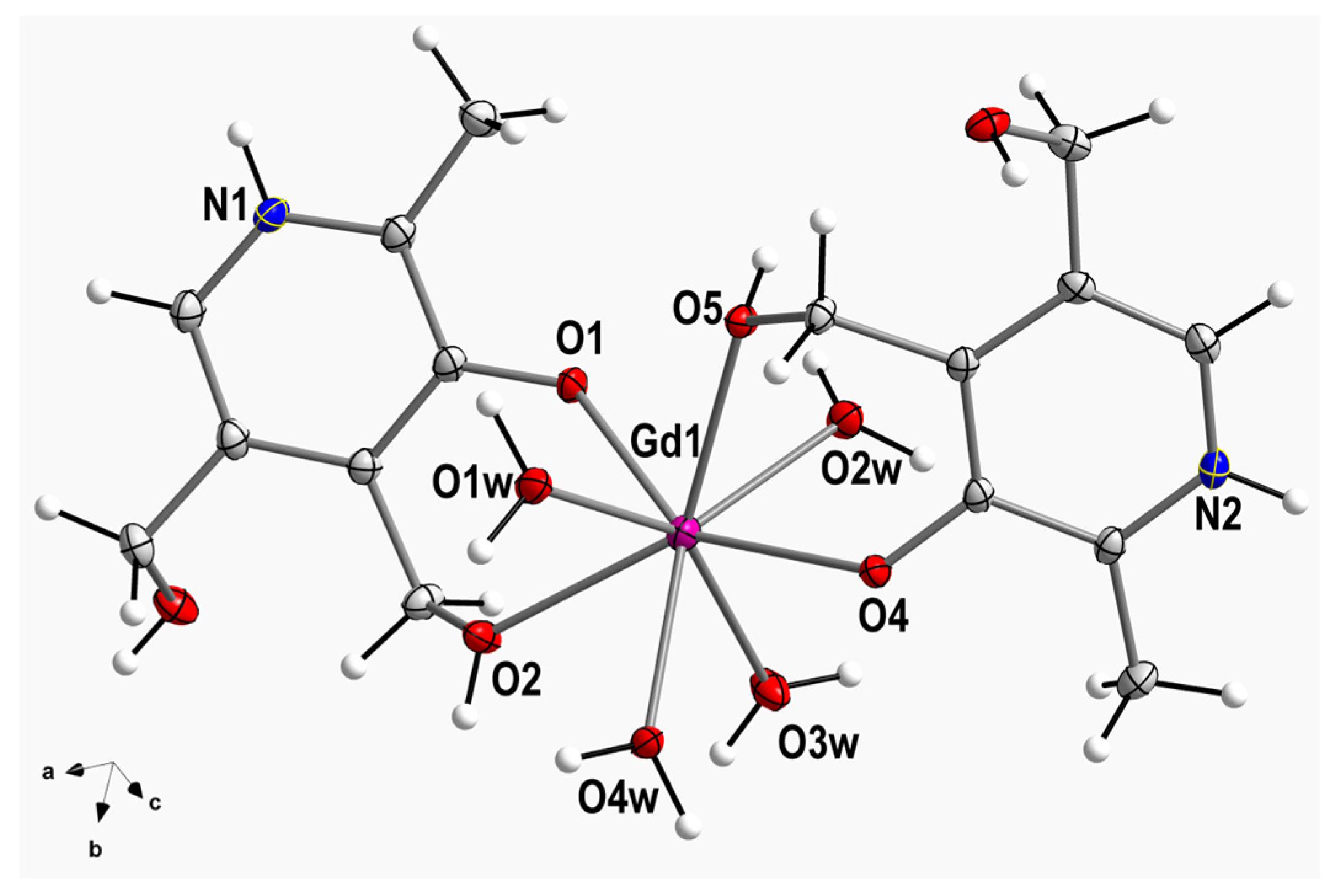
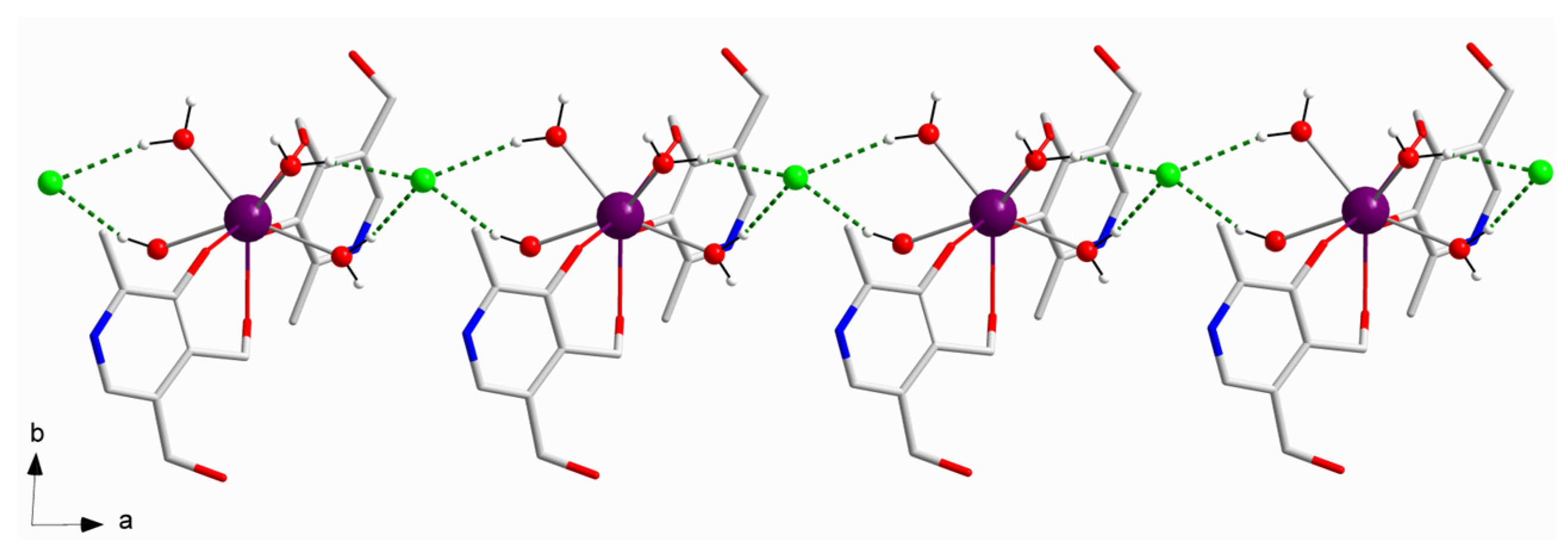
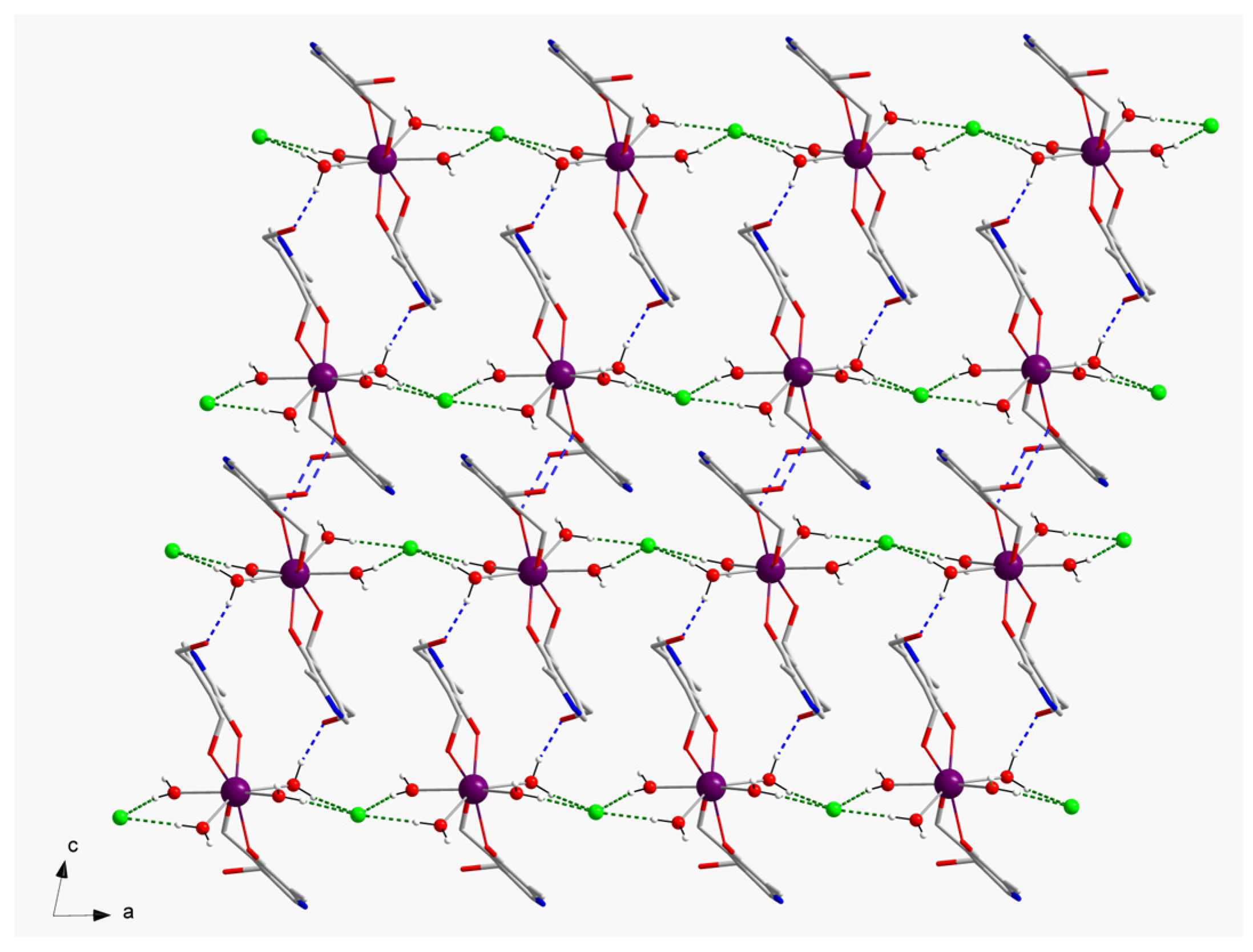
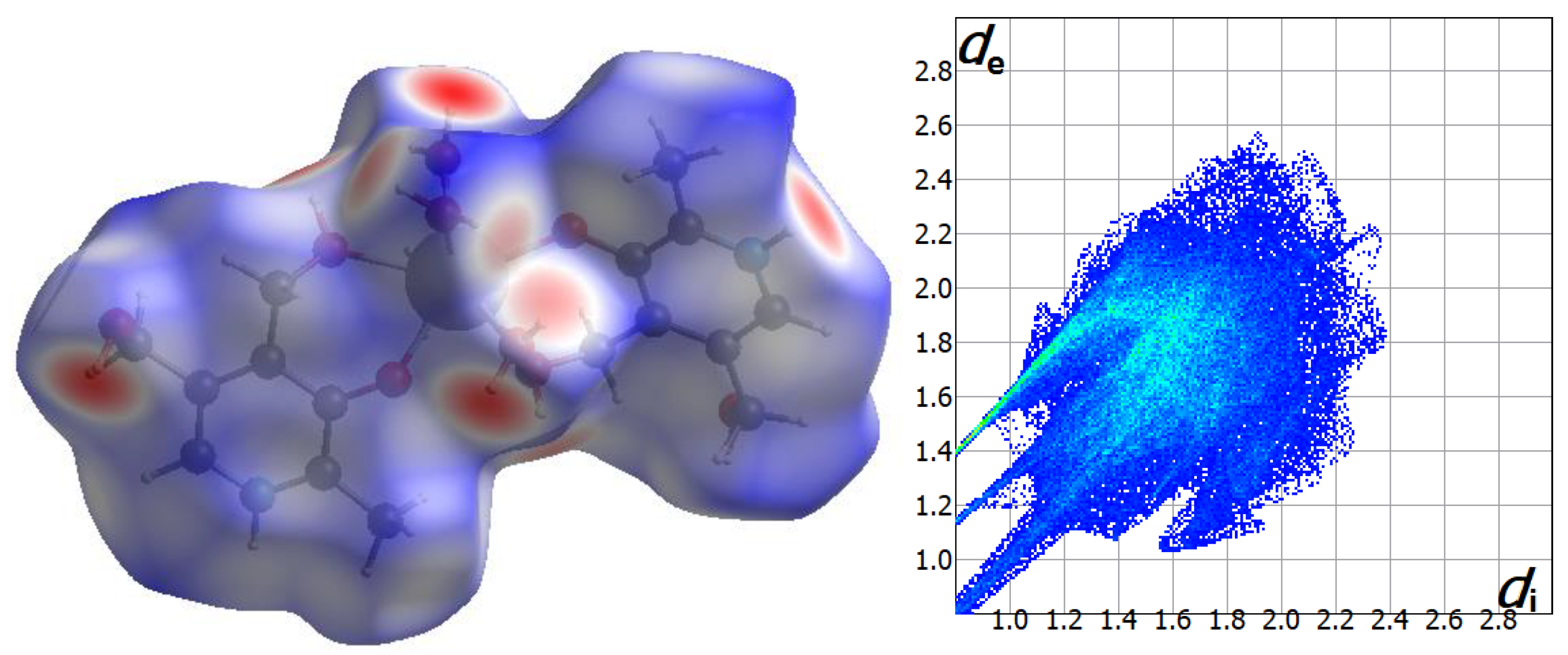
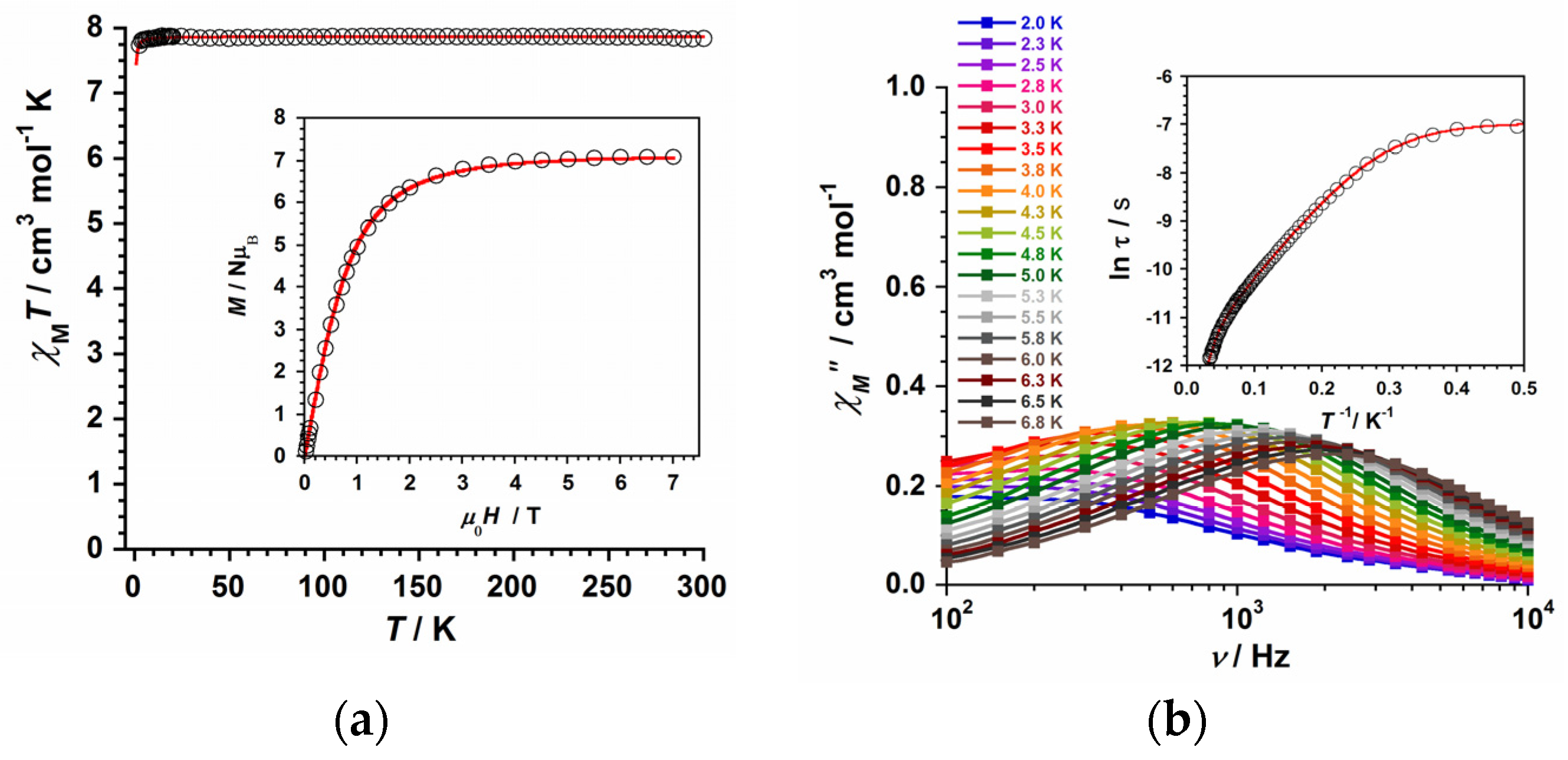
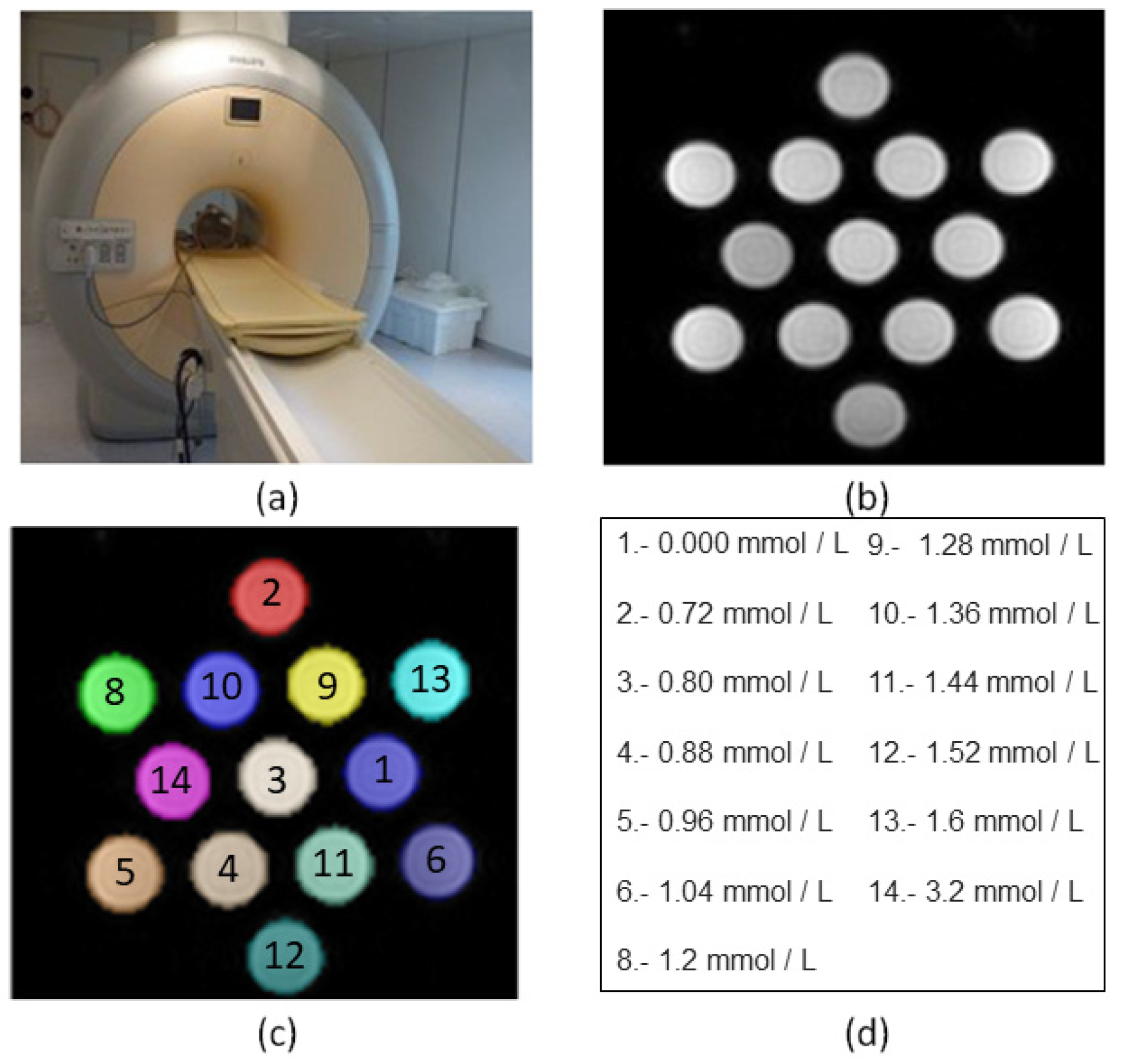
| Compound | 1 |
|---|---|
| CCDC | 2311814 |
| Formula | C16H34N2O12Cl3Gd |
| Fw/g mol−1 | 710.05 |
| Crystal system | Triclinic |
| Space group | Pī |
| a/Å | 9.042(1) |
| b/Å | 9.323(1) |
| c/Å | 16.265(1) |
| α/° | 79.92(1) |
| β/° | 76.68(1) |
| γ/° | 84.09(1) |
| V/Å3 | 1310.9(1) |
| Z | 2 |
| Dc/g cm−3 | 1.799 |
| μ(Mo-Kα)/mm−1 | 2.894 |
| F(000) | 710 |
| Goodness-of-fit on F2 | 1.068 |
| R1 [I > 2σ(I)]/all data | 0.0174/0.0199 |
| wR2 [I > 2σ(I)]/all data | 0.0382/0.0403 |
| D-H···A | D-H/Å | H···A/Å | D···A/Å | (DHA)/° |
|---|---|---|---|---|
| O2-H2B···O5w | 0.840 | 1.78(1) | 2.607(1) | 169.0(1) |
| O5-H5B···Cl1 | 0.840 | 2.27(1) | 3.064(1) | 159.0(1) |
| O1w-H1wA···Cl3f | 0.939 | 2.25(1) | 3.191(1) | 176.7(1) |
| O1w-H1wB···Cl2a | 0.940 | 2.21(1) | 3.133(1) | 166.3(1) |
| O2w-H2wA···Cl2 | 0.938 | 2.20(1) | 3.103(1) | 161.0(1) |
| O2w-H2wB···O3b | 0.943 | 1.80(1) | 2.730(1) | 169.0(1) |
| O3w-H3wA···Cl2 | 0.935 | 2.40(1) | 3.311(1) | 165.4(1) |
| O3w-H3wB···Cl1e | 0.940 | 2.12(1) | 3.064(1) | 178.7(1) |
| O4w-H4wA···Cl2a | 0.940 | 2.24(1) | 3.147(1) | 162.4(1) |
| O4w-H4wB···O6e | 0.940 | 1.80(1) | 2.743(1) | 178.6(1) |
| O5w-H5wB···Cl3c | 0.944 | 2.21(1) | 3.146(1) | 173.5(1) |
| O6w-H6wA···Cl3 | 0.948 | 2.16(1) | 3.107(1) | 174.7(1) |
| O6w-H6wB···Cl1g | 0.943 | 2.25(1) | 3.113(1) | 152.6(1) |
| N1-H1A···Cl3d | 0.880 | 2.40(1) | 3.218(1) | 155.3(1) |
| N2-H2A···O6w | 0.880 | 1.79(1) | 2.640(1) | 162.7(1) |
| O6-H6A···O4f | 0.892 | 1.99(1) | 2.749(1) | 161.2(1) |
| O3-H3A···Cl3h | 0.888 | 2.39(1) | 3.139(1) | 159.6(1) |
| O5w-H5wA···Cl1e | 0.955 | 2.25(1) | 3.165(1) | 159.4(1) |
| HPY | HBPY | CU | SAPR | TDD | JGBF | JETBPY | BTPR | JSD | TT |
|---|---|---|---|---|---|---|---|---|---|
| 23.736 | 15.589 | 11.208 | 1.441 | 0.948 | 13.244 | 28.568 | 1.632 | 2.696 | 11.950 |
Disclaimer/Publisher’s Note: The statements, opinions and data contained in all publications are solely those of the individual author(s) and contributor(s) and not of MDPI and/or the editor(s). MDPI and/or the editor(s) disclaim responsibility for any injury to people or property resulting from any ideas, methods, instructions or products referred to in the content. |
© 2024 by the authors. Licensee MDPI, Basel, Switzerland. This article is an open access article distributed under the terms and conditions of the Creative Commons Attribution (CC BY) license (https://creativecommons.org/licenses/by/4.0/).
Share and Cite
Orts-Arroyo, M.; Ten-Esteve, A.; Ginés-Cárdenas, S.; Cerdá-Alberich, L.; Martí-Bonmatí, L.; Martínez-Lillo, J. A Gadolinium(III) Complex Based on Pyridoxine Molecule with Single-Ion Magnet and Magnetic Resonance Imaging Properties. Int. J. Mol. Sci. 2024, 25, 2112. https://doi.org/10.3390/ijms25042112
Orts-Arroyo M, Ten-Esteve A, Ginés-Cárdenas S, Cerdá-Alberich L, Martí-Bonmatí L, Martínez-Lillo J. A Gadolinium(III) Complex Based on Pyridoxine Molecule with Single-Ion Magnet and Magnetic Resonance Imaging Properties. International Journal of Molecular Sciences. 2024; 25(4):2112. https://doi.org/10.3390/ijms25042112
Chicago/Turabian StyleOrts-Arroyo, Marta, Amadeo Ten-Esteve, Sonia Ginés-Cárdenas, Leonor Cerdá-Alberich, Luis Martí-Bonmatí, and José Martínez-Lillo. 2024. "A Gadolinium(III) Complex Based on Pyridoxine Molecule with Single-Ion Magnet and Magnetic Resonance Imaging Properties" International Journal of Molecular Sciences 25, no. 4: 2112. https://doi.org/10.3390/ijms25042112
APA StyleOrts-Arroyo, M., Ten-Esteve, A., Ginés-Cárdenas, S., Cerdá-Alberich, L., Martí-Bonmatí, L., & Martínez-Lillo, J. (2024). A Gadolinium(III) Complex Based on Pyridoxine Molecule with Single-Ion Magnet and Magnetic Resonance Imaging Properties. International Journal of Molecular Sciences, 25(4), 2112. https://doi.org/10.3390/ijms25042112








